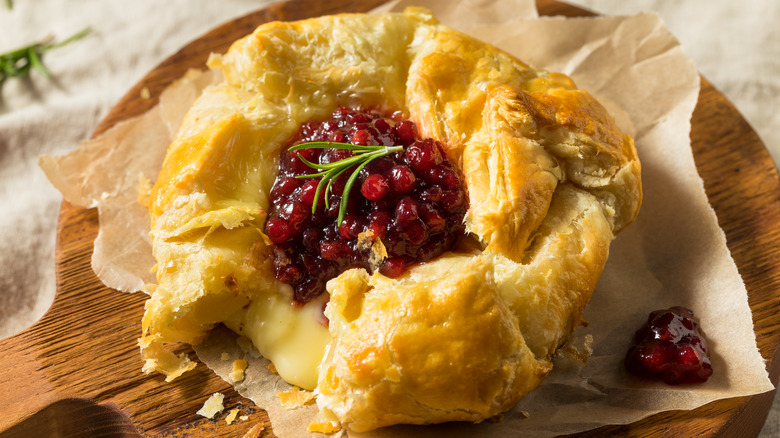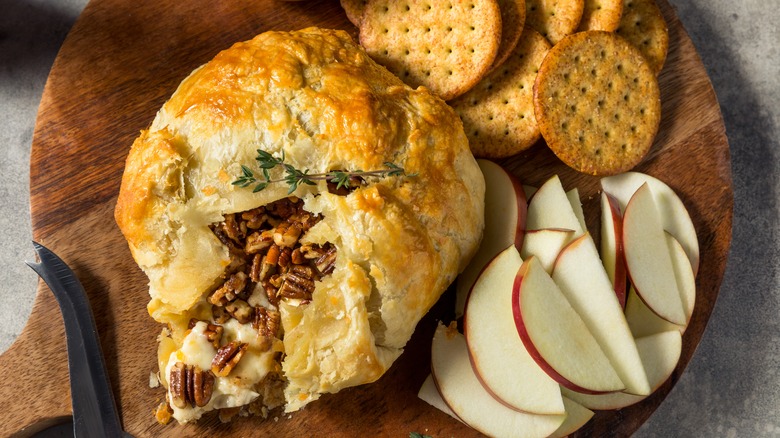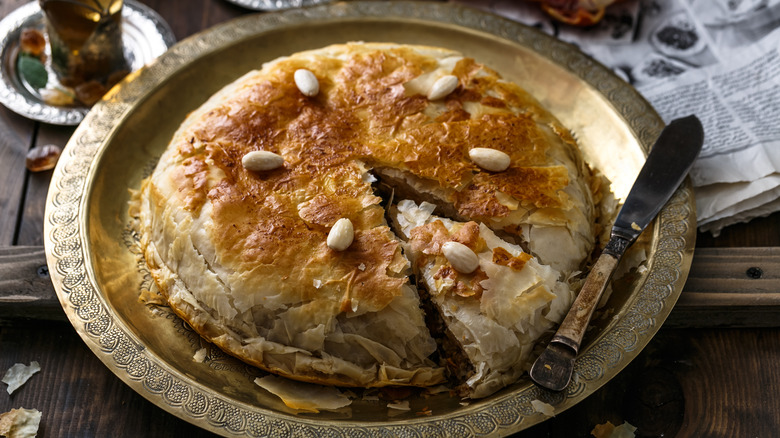The Pastry Swap That Will Take Your Baked Brie Up A Notch
If you're looking for an easy appetizer for your dinner party, a warm addition to a cheese board, or just a delicious cheesy snack, then look no further than a baked brie. Baked brie is great for all sorts of different occasions and can also be customized with unique fillings to satisfy personal or seasonal tastes.
Baked brie is typically a wheel of brie wrapped in a shell of puff pastry dough and then baked in the oven until the center becomes molten and gooey. You can also add nuts, jams, or other fillings alongside the brie to add more depth to this decadent appetizer. The Washington Post reports that baked brie first came to prominence in the 1990s as an easy appetizer.
Upgrade a baked brie by adding different fillings like honey or jalapeno jelly, though we recommend this recipe for baked brie with pecans and cranberry-orange chutney. There is also another way to upgrade the baked brie, and all it takes is a simple ingredient swap.
Swap puff pastry out for phyllo
It should be noted that it also isn't necessary to wrap your baked brie. Nerds with Knives points out that the crust is a delicious addition, but it isn't required by any means. That being said, the majority of the time folks talk about making a baked brie en croûte, they're talking about working with puff pastry.
To help elevate your baked brie, go for a phyllo dough instead of puff pastry. This will change up the texture of your baked brie and might be a forgiving hack when all the puff pastry disappears in the middle of the holiday season.
Allrecipes says that puff pastry is made by laminating dough with layers of butter in between. The butter puffs up and creates the light airy texture of croissants and danishes. In the case of the baked brie though, it also adds a semi-redundant richness to this already decadent dish. The phyllo dough, however, is lighter and crispier. It adds the texture of a good crust without interfering with the flavors of the cheese.
What is phyllo dough?
Phyllo is a light and layered dough that crisps up into beautifully light baklava, and savory spanakopita. Allrecipes explains that while the two doughs may seem very similar, there are slight differences that make phyllo and puff pastry stand apart from each other. Both are laminated and layered doughs but they utilize different fats. Phyllo uses oil instead of puff pastry's butter, which gives it a slightly different texture, per Allrecipes.
Bakerpedia adds that phyllo dough is the older of the two laminated doughs. Phyllo dough seems to have been invented in medieval Turkey around the 11th century. Meanwhile, Allrecipes says that puff pastry didn't appear until 16th-century Spain, and is likely a direct descendant of phyllo.
Phyllo also has a distinct advantage over puff pastry in that it is more forgiving. According to Bakerpedia, phyllo is able to easily be stacked and layered on top of each other without negatively affecting a dish's texture. If any dough rips or falls off, they can then simply be layered over yet again to seal in that gooey, delicious brie that serves as the star of the show.


